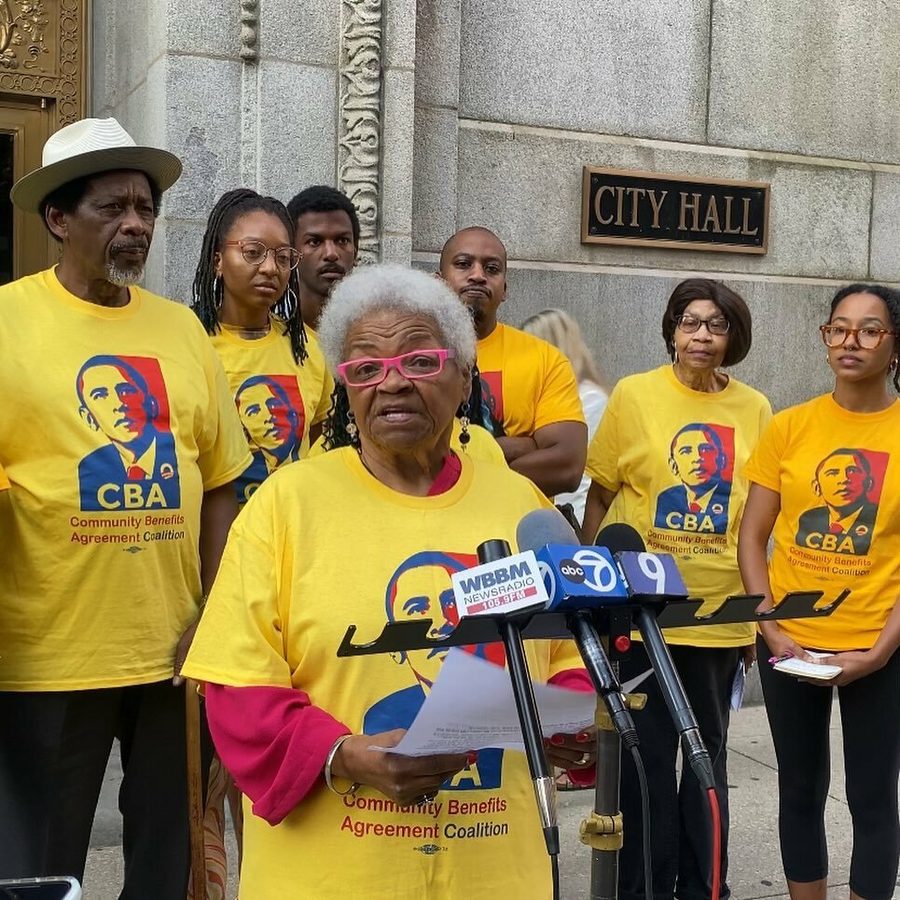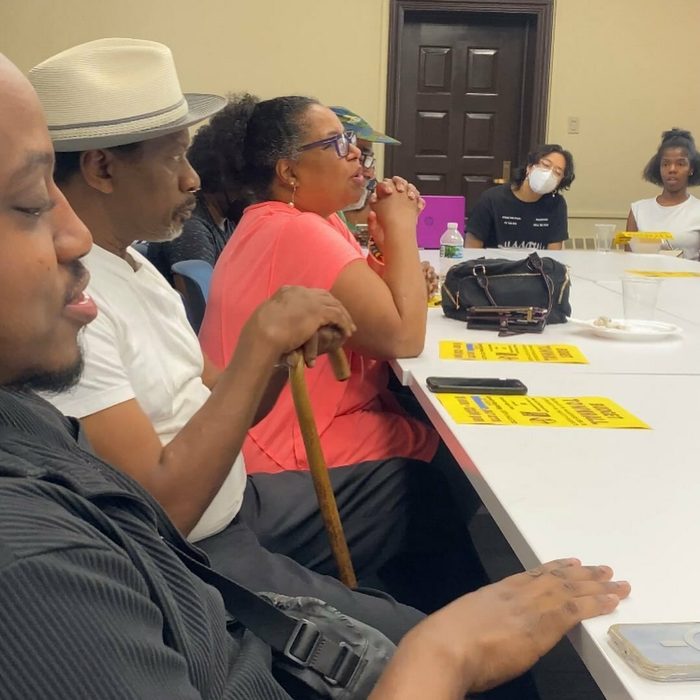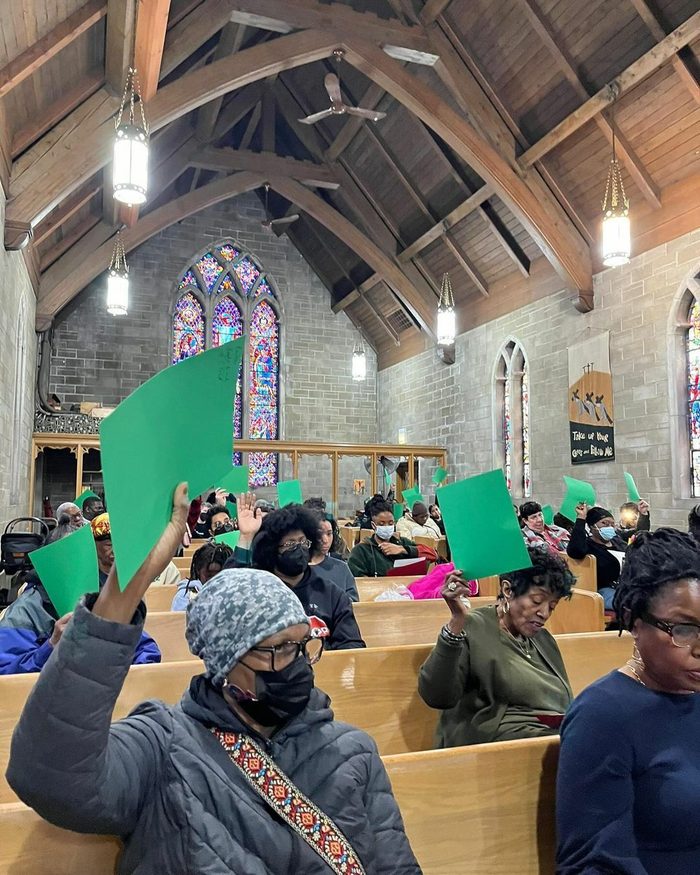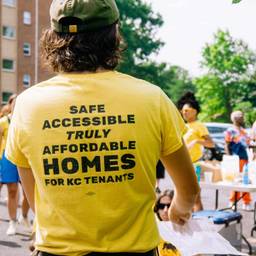In the Shadow of the Obama Center, Chicago Residents Fight Displacement
Investors are snapping up homes in the South Shore neighborhood, but a new tenants union is fighting back.
Fran Quigley

When Barack Obama met with Chicago residents about his proposed presidential center in 2018, the former president downplayed the threat that gentrification might pose to their communities.
“We’ve got such a long way to go in terms of economic development before you’re even going to start seeing the prospect of significant gentrification,” Obama said at a community forum where one attendee asked about the possibility of existing residents being pushed out. “Malia’s kids might have to worry about that.”
But now, six years later, residents of Chicago’s South Shore neighborhood are fighting fears of displacement amidst looming real-estate speculation in the area surrounding the $830 million project, set to open in nearby Jackson Park in 2026.
This spring, nearly 80% of voters in two nearby precincts backed a non-binding referendum demanding the city pass a suite of far-reaching protections to help longtime residents stay in their homes, including reserving city-owned lots for deeply affordable housing. A similar ballot measure in a dozen other South Shore precincts won even wider support in 2023. The South Shore Housing Preservation Ordinance remains stalled in Chicago City Council, but the campaign to pass it is attracting longtime residents like Vanessa Clay, who’s lived in her South Shore condominium for 24 years.
Lately, Clay says, the community has been changing around her. Nearby residents have reported rents being hiked by as much as 60%. During 2022, investors bought up nearly a third of for-sale homes in South Shore, the highest rate of investor purchases in the city. Clay and other South Shore residents fear that those investors are now waiting for the opportune time to sell at prices current neighbors cannot afford.
“It seems like developers are coming in here and taking over,” Clay says. But she is determined to stay.
To an outsider, the South Shore neighborhood may not appear to be an obvious candidate for gentrification. Three-quarters of the residents are renters, and the neighborhood population is 92% Black. A third of the population makes less than $25,000 per year and almost one in every six houses is vacant. What’s more, South Shore has often topped the list of neighborhoods with the city’s highest eviction rates, according to available data. But the history of Chicago and other urban centers shows that vacancies and evictions can set the stage for rapid gentrification.
“The city has a deep, long record of building itself up on the backs of poor Black and Latino folks, destroying their communities — either through ineptitude, lack of investment or intentional displacement,” says Dixon Romeo, executive director of Not Me We, a South Shore community organization organizing neighborhood tenants. “It doesn’t have to be this way.”
Not Me We was born in 2020, when Chicago Public Schools halted food deliveries to nearby Parkside Elementary during the uprising following George Floyd’s murder. When Romeo, a lifelong South Shore resident, learned that 70 children were relying on those meals, he worked with others to launch a mutual aid effort to distribute groceries. Soon after, they started helping their neighbors resist evictions.
The mutual aid effort, now called Feed the Babies, continues. But tenant organizing is at the center of Not Me We’s work. “Mutual aid alone is not going to fix the problems people are dealing with,” says Romeo, 30. “Folks are coming to mutual aid because they can’t afford groceries. You ask why and they say their rent is $1,500 and went up $300 last year. Our focus has always been to organize because that is what is going to get us out of the situation we’re in.”
It’s a Sunday afternoon in July, and in the community room in the South Shore branch of the Chicago Public Library, Romeo and fellow organizer Infiniti Gant are welcoming more than a dozen neighborhood residents to a teach-in about the forces of gentrification. After the residents visit the spread of fries, chicken and salad, a longtime community activist introduces herself to the group, followed by a man who is unhoused. Next is a young mother of three, then a woman who has lived in the neighborhood almost 60 years. Next to her, a student at nearby University of Chicago. All are neighborhood residents.
Romeo and Gant walk the group through a role-playing exercise where Romeo takes the part of a mayor pretending to listen to the community, only to dodge tangible commitments. Gant portrays “Infiniti Riches,” a wealthy business owner and real estate investor making the case for tax abatements and incentives. “That way I can hire more people and invest in the community,” she insists. When she makes an ask of Mayor Romeo, her campaign contributions spur more action than the community voices.
Romeo and Gant don’t overdo the play-acting, even smiling a bit when delivering some of their more outrageous statements. But the standard talking points they deploy about how development works, and who benefits, are so familiar that the assembled residents start to get genuinely upset. When Gant argues for the civic value of investing in sports stadiums, a woman in her seventies is not having it. “It’s no investment at all,” she says. “It’s just football. And it is going to raise the rents!” When Romeo says that downtown high rises will create more housing, the young mom demands to know, “For who?”
Anthony Edwards, 66, has been renting in the South Shore neighborhood for almost 20 years. Gant met him earlier in the week when doing outreach in the neighborhood, and she encouraged him to come to the meeting. “The new discrimination is money,” Edwards says. His voice rises in frustration. “They jack up the rent so we can’t afford to stay here. Gentrification is pre-planned!”

Gant, 26, grew up in an apartment with a view of Jackson Park. When she later saw photos of the park taken after hundreds of trees, some more than a century old, were torn up to clear space for the Obama Center, Gant began to fear for the community. She had her own experiences with the housing crisis: Her family was displaced three times due to apartments and houses being overrun with roaches, mold and, in one case, a fatal shooting in the building garage. Gant joined Not Me We and started working on the Obama community benefits agreement campaigns to protect the neighborhood.
Gant’s local work was diverted when she began studies for a master’s degree in sustainable community development, which included coursework in Ecuador, South Africa and Malawi. “But the more I studied quote-unquote ‘third world’ or developing countries,” she says, “the more I realized that there are places in the U.S. where the living conditions are the same — and one of those is my hometown!”
Gant returned to Chicago and began working for Not Me We last year. “Housing is a human right, and we take that very seriously,” she says. “Everybody should have a place to lay their head.”
It’s been nearly a decade since the Obama Foundation announced plans to locate on Chicago’s South Side and community organizations launched a campaign to secure a community benefits agreement, a type of legally binding contract between developers and communities impacted by their projects.
But Obama Foundation declined to enter into such an agreement, instead issuing a series of sweeping but unenforceable promises. “I know the neighborhood,” Obama said at the 2018 community meeting. “I know that the minute you start saying, ‘Well, we’re thinking about signing something that will determine who’s getting jobs and contracts and this and that’ … next thing I know, I’ve got 20 organizations coming out of the woodwork.”
Rebuffed by the former community organizer-turned-president, neighborhood groups shifted their attention to local government. Not Me We is affiliated with Southside Together Organizing for Power (STOP), which for 20 years has brought together area tenants and homeowners and pushed for more access to mental health treatment and programs for youth. Both groups are part of the Obama Community Benefits Agreement Coalition, which STOP helped found.
In 2020, the coalition’s efforts led to the passage of the Woodlawn Housing Preservation Ordinance, which requires 25% of city-owned vacant land to be set aside for affordable housing, dedicates funds for helping homeowners repair their buildings and gives renters the right of first refusal if a landlord seeks to sell their building. But amidst political tussling with the administration of previous Chicago Mayor Lori Lightfoot, the ordinance’s final version removed protections for the South Shore neighborhood.

So the coalition’s current campaign centers on the South Shore Housing Preservation Ordinance, which aims to help both homeowners and tenants stay in the neighborhood — and to create some new protections that would apply citywide. The proposed measures include a new Office of the Tenant Advocate, a $15 million rental assistance fund, a right to return for tenants displaced by building code violations and a cap on application fees and security deposits. (Illinois law preempts rent control, but a statewide “Lift the Ban” campaign is challenging that, too.)
The ordinance would also provide South Shore-specific funding for home repairs for longtime residents like Vanessa Clay, who has returned to work as a caregiver so she can afford the hefty maintenance costs for her building. And it would extend assistance and debt relief to eligible South Shore homeowners who struggle to keep up with property tax payments, while setting aside most city-owned South Shore vacant lots for the development of affordable housing.
At a 2023 candidate forum hosted by Not Me We, Chicago City Council candidate Desmon Yancy promised to introduce the South Shore ordinance during his first 100 days in office. That promise helped Yancy win the seat, and he introduced the ordinance in September of 2023. But even after two rounds of referenda wins, its future is uncertain. Yancy told supporters in June that the ordinance needed more support if it was going to pass the City Council this year, as did Mayor Brandon Johnson. Meanwhile, local business and real-estate interests are pushing to strip tenant-friendly measures from the ordinance.
Two other City Council members whose wards overlap South Shore, Michelle Harris and Greg Mitchell, have yet to back the proposal. They did not respond to a request for comment.
Not Me We is undeterred. “When we are going door to door talking with people, it is clear they want this ordinance,” Gant says. “People don’t want to leave the neighborhood, but they are seeing the shift in prices and different people coming in. There is a lot of frustration and fear.”
Anthony Edwards and Vanessa Clay, more than a generation older than Romeo and Gant, see the difference as well. “It has rekindled something in us to see young people joining with people from all ages in our community to stand up for ourselves,” says Edwards. “Nothing is going to be changed by just wishing it away.”
Clay remembers being shocked when Not Me We canvassers came to her door, asking about what she and her neighbors were going through and inviting her to attend the next community event. “They are doing tremendous things,” she says. “Every time they have a meeting, it seems there are more and more people there — particularly seniors. That is good news, because we have a fight on our hands.”
Back at the South Shore branch library, Romeo ends the teach-in by making the case for mobilizing more neighbors behind the ordinance.
“I don’t care if you make zero dollars, I don’t care if you went to Harvard Law School,” he says. “You deserve to live wherever you want to live in the city of Chicago, and that needs to start in Black neighborhoods.”
Fran Quigley directs the Health and Human Rights Clinic at Indiana University McKinney School of Law.







